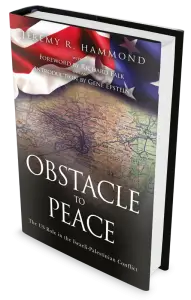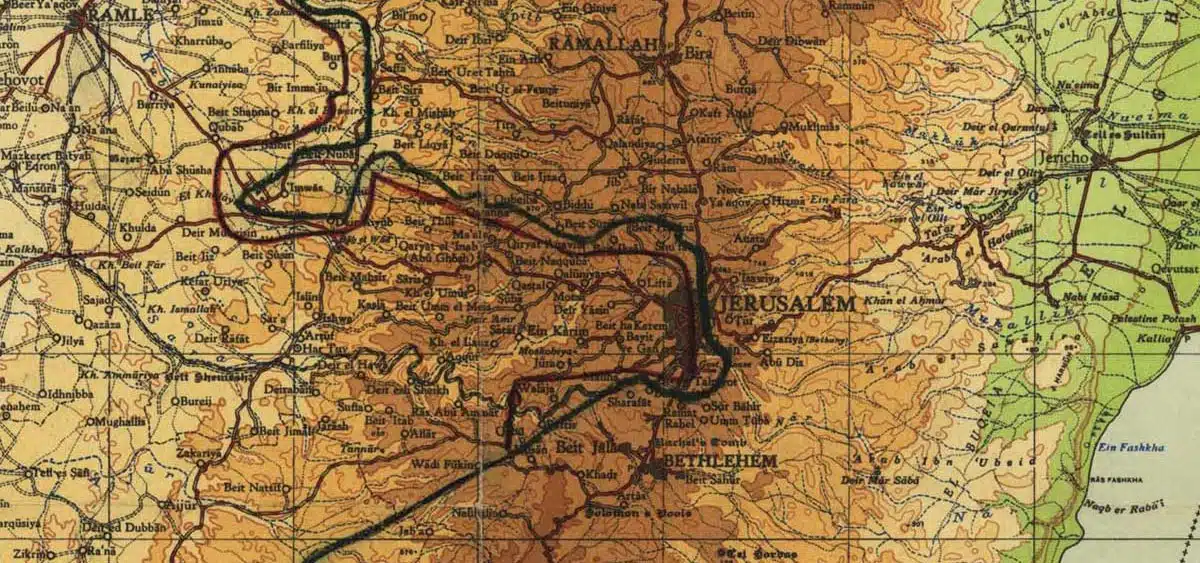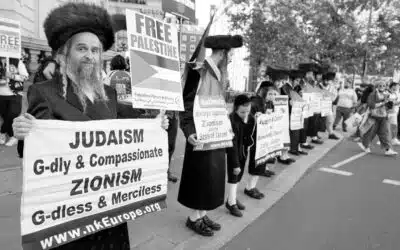Table of Contents
Introduction
When Donald Trump last week suggested he was looking at alternatives to the two-state solution, the New York Times naturally sought to provide its readers with some context about what the two-state solution is. Unfortunately, rather than properly informing its audience, it resorted to the standard propaganda narrative.
According to a Times article on Trump’s comment, “The idea of an independent Palestinian state comprising the West Bank and Gaza became the central theme of Middle East peacemaking in the 1990s after the Oslo Accords were signed.”
And according to the the editorial board, “The two-state solution began to take shape after the 1993 Oslo accords and was endorsed by President Bill Clinton in 2001.”
The former statement is at best disingenuous, and latter is an outright lie.
What the Times is doing here is equating “two-state solution” with “peace process”. There are two Big Lies here: one, that the two-state solution began with the “peace process” and, two, that the “peace process” was intended to bring about the two-state solution.
So let’s set the record straight:
First, there has been an international consensus in favor of the two-state solution since the mid-1970s, and it was rejected from inception by Israel and the US. In January 1976, when the UN Security Council voted on a resolution expressing this international consensus, the US vetoed it.
Second, the purpose of the so-called “peace process” was never to bring about the two-state solution, but to block its implementation.
This is clear to anyone who understands what the two-state solution actually is.
So what is the two-state solution?
Well, the Times’ “Interpreter”, Max Fisher, recently wrote a piece titled “The Two-State Solution: What It Is and Why It Hasn’t Happened” in which he purports to explain it to readers.
He doesn’t.
On the contrary, Fisher writes, for example, that “Benjamin Netanyahu, the Israeli prime minister since 2009, endorsed the two-state solution in a speech that year.” This assertion simply illustrates that Fisher himself has no understanding of what the two-state solution is.
What he is referring to is a speech by Netanyahu at Bar-Ilan University in Tel Aviv on June 14, 2009. In that speech, Netanyahu emphatically did not endorse the two-state solution. Netanyahu, rather, insisted that Israel’s illegal settlement regime would continue in defiance of international law and rejected the Palestinians’ equal right to self-determination. That is to say, Netanyahu’s speech amounted to an explicit rejection of the two-state solution.
To understand what the two-state solution is, we need to go back to 1967.
During that war, Israel occupied the Syrian Golan Heights, Egyptian Sinai Peninsula, and the Palestinian territories of the Gaza Strip and West Bank, including East Jerusalem.
In the wake of the war, the UN Security Council passed Resolution 242, which called on Israel to return to the lines it held prior to June 5, when it started the war with a surprise attack on Egypt.
Those lines are today known as the “1967 lines”, which is synonymous with the 1948 armistice lines or the “Green Line”, so called for the color with which it was drawn on the map.
Israel claims to accept Resolution 242, but this is a lie. What Israel accepts isn’t the actual resolution, but its own unilateral reinterpretation of it.
The US, for its part, while voting in favor of the resolution at the time, later, under the so-called “peace process”, adopted Israel’s unilateral reinterpretation.
The Zionist reinterpretation of Resolution 242 maintains that it did not call on Israel to fully withdraw from the occupied territories, but that it allowed for Israel to retain some of the conquered territory.
This reinterpretation is untenable.
UN resolutions are not open to unilateral interpretation, but must be understood according to the will of the Security Council as a whole; and the Security Council was unanimous that the resolution required Israel to withdraw to the positions it held prior to June 5, 1967.
The wording of the resolution makes this clear.
In the preambulatory section, the Council emphasized that the acquisition of territory by war is inadmissible. The Zionist reinterpretation is irreconcilable with that principle of international law.
The Zionist reinterpretation also maintains that the absence of the definite article “the” before the words “territories occupied” in the operative clause calling for withdraw meant that the Council didn’t intend for Israel to withdraw completely. That is, since the clause didn’t call for “Withdrawal of Israel armed forces from the territories occupied in the recent conflict”, we must therefore understand it to mean “Withdrawal of Israel armed forces from some of the territories occupied in the recent conflict” — patently absurd and self-defeating logic.
As a simple point of English grammar, the absense of the article has no effect on the meaning of the clause insofar as the extent of withdrawal is concerned. The Golan Heights, the Sinai Peninsuala, Gaza, and the West Bank were all “territories”, plural, that Israel occupied during the war and hence “territories”, plural, from which Israel was required to withdraw in keeping with the emphasized principle of international law that acquisition of territory by war is inadmissible.
Another tenet of the Zionist reinterpretation is that that subclause calling for withdrawal was made conditional upon the one that followed it, which called for peace and the establishment of “secure and recognized boundaries”.
However, it was certainly not the intent of the Security Council that the Palestinians must negotiate with their oppressors while the Occupying Power continued to prejudice the outcome of those negotiations by building “facts on the ground” under its illegal settlements regime.
Had that been the Council’s intent, it would have meant Resolution 242 was in violation of the very Charter under which it was operating, and hence illegal, null and void — but that wasn’t the Council’s intent, as is clear in the documentary record of the debates prior to the vote, during which the consensus was that Israel was required to fully withdrawal.
So what is the “peace process”?
Simply stated, the “peace process” is the process by which Israel and the US have long blocked implementation of the two-state solution.
It is premised upon a rejection of the applicability of international law toward resolving the conflict.
It is premised upon a rejection of the equal rights of the Palestinian people.
Now, it’s true that both Israel and the US have expressed support for a two-state solution. However, while the media perpetually equates what Israel and the US have expressed support for with “the two-state solution” (as seen in Max Fisher’s piece), they are emphatically not the same thing.
The US may support a two-state solution, but it is not the two-state solution, in terms of the international consensus grounded in the applicability of international law.
Regrettably, many supporters of Palestinian rights today reject the two-state solution because they, too, have come to equate it with the the so-called “peace process” and Israel or the US’s concept of what a Palestinian state would look like.
In essence, to implement the two-state solution would be to end the occupation regime. Or, to put it differently, to end the occupation regime would be to implement the two-state solution.
This is not to say that a single, democratic state with equal rights for all its citizens comprised of all of the territory of Mandate-era Palestine would not be a possible or desirable outcome. But it must be recognized by supporters of Palestinian rights that there is no way to get there without first implementing the two-state solution, which is to say, without first ending the occupation regime.
So how can the occupation regime be ended?
To end the occupation regime, the Palestinians must reject the so-called “peace process”. They must withdrawal from the Olso Accords and turn to the international community to enforce international law and uphold their rights.
After all, Israel’s obligation to comply with international law is non-negotiable.
And Palestinians’ human rights, including the right to self-determination, are non-negotiable.
In November 2012, there was a vote in the UN General Assembly on whether to upgrade Palestine’s status from “observer” to “non-member state”. The US and Israel rejected this bid and mocked it as purely “symbolic”. (The mainstream media joined in that chorus, naturally.)
It was not merely symbolic, and US and Israeli policymakers understood that perfectly well. They understood that for Palestine — which had already been recognized by most of the world’s governments — to be recognized as a state by the UN would mean that the Palestinians would have recourse through international legal mechanisms like the International Court of Justice (ICJ) and International Criminal Court (ICC).
Israel and the US tried vainly to prevent that status upgrade from happening for the obvious reason.
It’s been over four years since Palestine was recognized by the UN as a state. So why hasn’t the the ruling Palestinian Authority under Mahmoud Abbas aggressively pursued legal remedy for Israel’s crimes against their people?
The reason the PA hasn’t done so is because of the nature of this body. It was a product of the “peace process”. It was created under the Oslo Accords to serve a purpose, which was effectively to serve as Israel’s collaborator in enforcing the occupation regime.
Without getting too deeply into the details, essentially, it seems prerequisite that the PA be dissolved for the Palestinians to be able to move forward. The Palestine Liberation Organization (PLO), the PA’s parent organization, has the authority to withdraw from the Oslo Accords and dissolve the PA.
If the PA won’t do what is necessary, the Palestinian people will have to rise up and replace it with a leadership that will serve their interests rather than the interests of their oppressors.
 Conclusion
Conclusion
The New York Times certainly isn’t alone in deceiving readers about what the two-state solution is. The entire mainstream media without fail echo the same Big Lies about the conflict, serving to manufacture consent for the US government’s rejectionist policy.
If peace is to be realized, a proper understanding of the two-state solution and the so-called “peace process” is essential. To learn more, see my book Obstacle to Peace: The US Role in the Israeli-Palestinian Conflict, available from www.obstacletopeace.com.





And if the Israeli Zionist Regeime did not sabotage the reelection of President Carter, there would have been two states. But, Menachem Begin was spitting venom when he was forced to shake hands and make peace with Sadat and the Egyptians. Great analysis, Jeremey.
Thank you Jeremy, brilliant job.
Thanks for the comment!
— Israel’s unilateral reinterpretation–
It can be easily concluded that Israel- Palestine relationship is just akin to Wolf-Lamb encounter – Wolf at the upper end of the streams complains that the lamb has spoiled the water although this poor creature is at the far lower end.